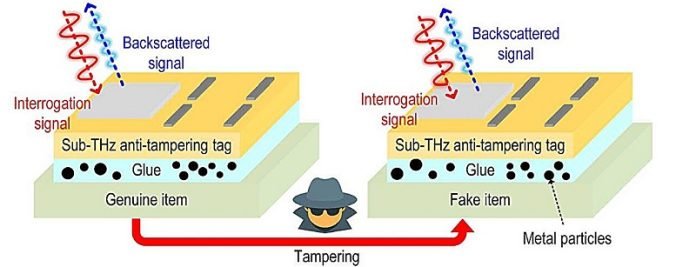
Researchers from MIT have created a tiny, cost-effective, and secure tag that’s a game-changer in the fight against counterfeit products.
This isn’t just any ordinary tag; it’s a smart solution that uses cutting-edge technology to make sure items are genuine, from luxury goods to medical devices.
Traditional tags, known as RFIDs, have been used for years to verify the authenticity of products.
These tags use radio waves to communicate information. However, the MIT team went a step further by using something called terahertz waves.
These waves are much smaller and faster, allowing for improved security features.
But here’s the catch with both old and new tags: if someone wanted to sell a fake item as real, they could just peel the tag off a genuine product and stick it on the counterfeit. The MIT team realized this flaw and came up with a brilliant solution.
By mixing tiny metal particles into the glue that attaches the tag to the item, they created a unique pattern, like a fingerprint, on the item’s surface. Terahertz waves, when used with this new tag, can read this fingerprint and verify if the item is real. If someone tries to remove and reattach the tag, the unique pattern is destroyed, making it impossible to fool the system.
Eunseok Lee, a leading researcher on the project, explains that these metal particles act like tiny mirrors for the terahertz waves. Depending on how these “mirrors” are spread out, they reflect patterns back to the tag, which can be used to identify if the tag has been tampered with.
This new tag is not only smart but also tiny—about the size of a pencil eraser—and incredibly cheap to produce. This means it can be used widely across various products, even those too small for traditional RFIDs.
The tag works by letting terahertz waves pass through and hit the metal particles in the glue. These waves bounce back in unique patterns that are read by a receiver. The tag has multiple slots allowing it to capture more information from different points on the item’s surface.
Ruonan Han, who led the research, was inspired by a simple car wash membership tag and sought a more reliable method to prevent tampering. Instead of relying on the tag itself, the new method focuses on the bond between the tag and the item.
After attaching the tag, the initial “fingerprint” reading is stored in the cloud. Later, this data can be used to check if the item is genuine. The system is designed so that it’s almost impossible to duplicate the unique response generated by the tag, as long as the glue interface is disturbed.
This innovation is a collaboration between Han’s team and other MIT researchers, highlighting the power of combining different fields of expertise to solve real-world problems. The project showcases a leap forward in security technology, making it much harder for counterfeit products to pass as genuine and offering a new level of protection for manufacturers and consumers alike.
In summary, MIT’s new antitampering tag is a small but mighty tool in the fight against counterfeiting.
By using advanced technology and a clever approach to security, it promises to make our products safer and more reliable than ever before.



